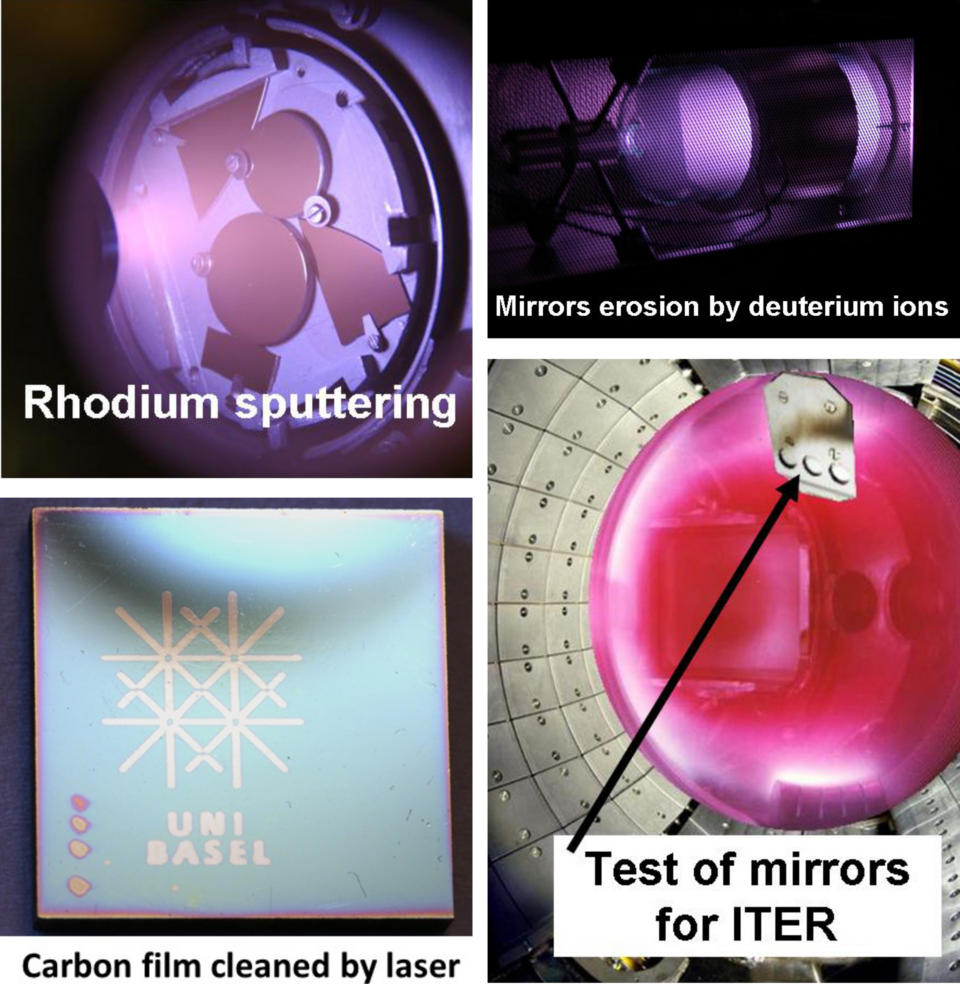Plasma-wall interaction studies related to fusion reactor materials

In a fusion reactor, and especially in the International Thermonuclear Experimental Reactor (ITER), knowledge of the plasma parameters is of highest interest to control and understand the performances of such a device. In today's tokamaks, the plasma is viewed through optical windows or fibre optics for many diagnostics. However, the high level of radiation expected in ITER will render this conventional approach impossible.
Metallic mirrors will be used either as plasma-facing components or as light transmitter through a labyrinth, and therefore the first mirror (FM) will be one of the most critical elements of ITER diagnostics systems. It must survive in an extreme environment (intense UV and X-rays radiation as well as particle fluxes due to charge exchange neutrals) and has to maintain a good optical performance.
In Basel, research is focused on the investigation of the erosion and deposition mechanisms affecting the optical reflectivity of potential materials for first mirrors of ITER both by active collaborations with groups from different Tokamak sites and by simulation in laboratory experiments. Another part is the preparation of metallic coated mirrors by magnetron sputtering or evaporation, to obtain nanometric crystallites films, like rhodium or molybdenum, with a high reflectivity.
The last topic is to study the interaction of the first wall (tungsten) of fusion reactor with several plasma especially for DEMO (DEMOnstration Power Plant).
Cleaning of mirrors either by plasma or laser is also investigated.
- Plasma cleanning for the ITER Equatorial Port Wide Angle Viewing System (WAVS) diagnostic.
- University of Basel News: Saubere Spiegel für den Fusionsreaktor, April 2015
- ITER newline: Testing cleaning techniques for diagnostic mirrors, April 2015.
- Energy research and innovation Report 2013 - page 24 (in englich) link to pdf 1.
- Energieforschung und Innovation Bericht 2013 - page 24 (in german) link to pdf 2.
- Recherche énergétique et innovation Rapport 2013 -(in french) page 24 link to pdf 3.
- Article in "Baslerstab", 28th of April 2011 (in german) part 1 and part 2 4/5.
- Article in "Schweizerische Technische Zeitschrift", April 2011 (in german) STZ link to pdf 6.
- Article in "Technica Fusion", December 2010 (in german) Technica Fusion Dez 2010 link to pdf 7.
- Article in "Basler Zeitung", 9th of July 2010 (in german) BaZ link to pdf 8.
Single crystal rhodium surface exposed to argon ions

In ITER, the metallic first mirrors (FMs) will undergo erosion due to their proximity to the fusion plasma and deposition of materials originated from the first walls. In-situ plasma cleaning is a promising technique to conserve the FMs optical properties by means of ion sputtering. In this context, consecutive depositions and removals of Al2O3 contaminants (proxy for beryllium oxide) using 310 eV Ar ions were performed on single crystal rhodium mirrors. The polishing procedure was shown to lead to the formation of pits.
Plasma-catalysis for ammonia production
| On 19th November 2020, Rodrigo Antunes participated in the diss:kurs 2020 in which, together with other 6 PhD students and postdocs, he presented his main postdoc topic on “plasma-catalysis for ammonia production” in layman terms. All contributions can be viewed in Diss:kurs webpage. The videos were recorded at the New Media Centre of the University of Basel. |
